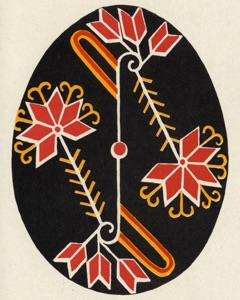Bukovyna
Буковина
Bukovyna
Буковина

Bukovyna is located in western Ukraine, and is comprised of the Rumanian-influenced lowlands and the Hutsul Highlands. The area was under Rumanian control through WWII, and it is an area of mixed ethnicity.
This pysanka is from Onyshchuk’s book, and is an example of Bukovynian ones that she refers to as “Rooster” pysanky. I translated «косиця» (kosytsya) as scythe, as that is what I saw when looking at the design. However, the Ukrainian dictionary gives several possible translations, including “braid” and “a type of flower.” A similar design from Binyashevsky (below) is called a “silk kosytsya” which is a Ukrainian name for the edelweiss flower.

In actuality, these ancient motifs are representations of the Berehynia. An intersected sigma (“S”) shape is a common representation of the goddess, with the two heads signifying the dual nature of the goddess: summer and winter, good and evil, life and death, heaven and earth. The intersected sigma design is relatively common in Bukovyna and other regions, and is often referred to as “kucheri (curls) with wings.”
A characteristic feature of berehynia motifs is the crown on her head. On folk pysanky, this is sometimes recognized as such, and the motifs are referred to as “princess,” “queen,” or “young lady.” In her book Onyshchuk has a series of such pysanky called “roosters”: the crown has been reinterpreted by her as a rooster's comb.
Although I suspect that “Scythe” is probably an incorrect translation of the name, I haven’t had a chance to re-do the pattern below and change it, so it remains for now.

Technical details: this is a moderately difficult pysanka; although the design is fairly straightforward, it has lots of hatching, dots and small design features, which make it harder to write for beginners. A fine or medium stylus should be used for the lines, and a medium for waxing in and dots.
This pattern utilizes four dyes: yellow, green (as spot dye), red and black.
This is a simple lateral division; the design on the back should mirror the one on front.
The example in the photo above contains an error/modification: hand/finial has not been added to the crosspiece in step 2 (yellow). The pattern itself has an error–the crown is not shown colored in, as it should be in the last step (red).
Download this pattern sheet:
Back to Bukovyna Home
Back to Carpathian Pysanky Home
Back to Regional Pysanky Home
Back to Traditional Pysanky HOME
Search my site with Google
Scythe
Косиця
